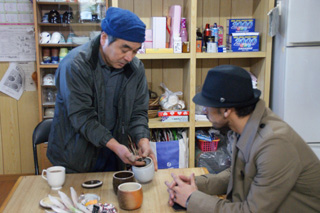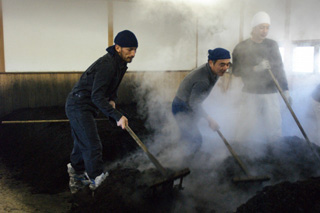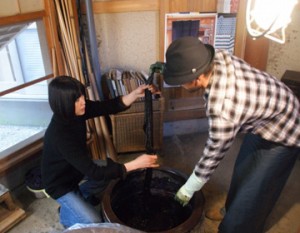Japanese indigo rooted in people’s lives
Japan Blue means the Japanese national soccer team. But it also means another thing known to the world. That is the deep and brilliant blue of Japanese ”ai-zome”. It is said that the British scientist who came to Japan in the early Meiji period, Robert William Atkinson saw Japanese indigo rooted in people’s lives, and called it ”Japan Blue”. Incidentally, familiar Indigo Blue indicates Indian indigo, which generates a deep blue and became popular as a dye all over the world.
Speaking of the production district of this Japan Blue, Awa-no-kuni (Awa Province) has been famous since olden days. It is said that in Awa, ”ai-zome” was already conducted by using Sukumo (fermented indigo leaves) in the late Muromachi period.

Overcoming era of prosperity followed by decline
Why did ”ai-zome” flourish in Tokushima? The reason was related with the floods which occurred in the Yoshino River basin.
The Yoshino river basin used to suffer from repeated floods. Farmers had to cope with the disasters, but as a matter of fact, the floods brought about a good environment for the cultivation of indigo. As each flood replaced the old sandy soil with new humid and fertile soil, suitable to cultivate the plant. Accordingly, cultivation developed, then after entering the Edo period, indigo production was strongly supported by the domain lord, the Hachisuka family, and came to enjoy great prosperity.
However, in the late Meiji period, it started declining in the face of good and inexpensive Indian indigo and chemical dyes. In 1966, even in Tokushima where the industry used to flourish, the cultivation area of indigo fell to only four hectares. But, subsequently, the natural texture has regained acclaim, and the demand has increased little by little. At present, most of ”sukumo” used in Japan is produced in Tokushima.

Producing the traditional “sukumo”
The factory of Osamu Nii is one of the production sites of ”sukumo”. As the number of indigo masters called ”ai-shi” who produce ”sukumo” has decreased, Nii, who possesses the Awa indigo production technology that is designated as a National Cultural Property, is one of five remaining indigo masters. Nii has fermented indigo to produce ”sukumo” while engaging in the production of indigo by his own company.
The ”sukumo” production requires skilled technique and a lot of labor.
Indigo’s faded color after washing in water many times is quite attractive, as well as its vivid color and soft texture when first used. The beauty of indigo has been loved in a timeless manner.





